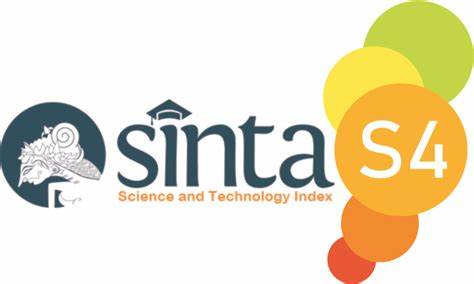Pengembangan Sound Card Laptop sebagai Alat Praktikum Fisika untuk Penentuan Percepatan Gravitasi Bumi
Abstract
The purpose of this research is to develop a laptop soundcard as a physics practice tool for the determination of Earth grafitational acceleration. The Earth's gravitational force is the power that makes the Earth draw objects to its center. This tool is designed using 3 pieces of copper coil separated by a certain distance. The Data obtained is presented in the form of Time (t) which is calculated from the symptoms of induction by magnetic through the coil. When the magnet is dropped, time is measured from the emergence of pulse when the magnet induces the coil using the Audacity software. From the Pulse brings out the results of time in each distance. This research uses development methods with Analysis, Design, Development, Implementation, Evaluation (ADDIE). The laptop's practicum soundcard tool is validated by expert tools for technical aspects and students as a test user. Data collection techniques in this research using poll. Angket is used to measure the feasibility of the development of laptop soundcard equipment. The poll is given to 3 members of the Practicum tools and students as a user. A poll validation analysis uses a Likert scale with a value range of 1 to 5. This results in a practical tool that has a good graphing perceptant measurement accuracy with a 2.33% error. While the result of validation shows that both validation provides excellent responsiveness so that, practicum soundcardlaptop tool can be used practicum.
References
Coe, R. (2002). It's the Effect Size, StupidWhat effect size is and why it is important. British Educational Research Journal (BERJ),28(1), 9-16.
Dahlan, M.S. 2009. Statistik untuk Kedokteran dan Kesehatan, Edisi 4 (Deskriptif, Bivariat dan Multivariat, dilengkapi Aplikasi dengan Menggunakan SPSS).akarta: Salemba Medika
Fahrudin, A. (2018). Development of Physics Summary Book as a Smartphone-BasedApplication and Its Effect on Elasticity Learning Achievement. Kasuari: Physics Education Journal (KPEJ), Vol 1, No. 1, Hal 22-33
Haisy, M. C., Astra, I. M., & Handoko, E. (2015, October). Pengembangan Alat Peraga Resonansi dan Efek Doppler Berbasis Soundcard PC/Laptop untuk Meningkatkan Motivasi Belajar Fisika Siswa SMA. In PROSIDING SEMINAR NASIONAL FISIKA (E-JOURNAL) (Vol. 4, pp. SNF2015-II).
Ishafit. (2012). Teknologi Informasi dan Komunikasi dalam Pembelajaran Fisika:Komputerisasi Eksperimen Bunyi Berbasis Soundcard Laptop. Prosiding SeminarNasional Fisika UNJ 2012.Jakarta: UNJ.
Kyriazis, A., Psycharis, S., &Korres, K. (2009). Discovery Learning and the ComputationalExperiment in Higher Mathematics and ScienceEducation: A Combined Approach. International Journal of Emerging Technologies in Learning (iJET), 4(4), 25-34.
Lovisia, E. (2019). PENERAPAN METODE EKSPERIMEN TERHADAP HASIL BELAJAR FISIKA SISWA KELAS XI SMA NEGERI 2 MUARA BELITI. SILAMPARI JURNAL PENDIDIKAN ILMU FISIKA, 1(2), 114-120.
Muller, H. (2018). Quantum Gravity Aspects of Global Scaling and the Seismic Profile of the Earth.Progress In Physics, 4(1), 41-45.
Permana, I., &Rohma, I. (2012).Visualization Multimultimedia To Enhance Concepts Understanding And Generic Science Skills Of Vocational High School Students On The Hydrocarbons Concept. Jurnal Pengajaran MIPA (JPMIPA), 17( 1), 132-141.
Rosariana, G., Sudin, A.,& Sujana, A. (2016). Penerapan Model Discovery Learning untuk Meningkatkan Hasil Belajar Siswa pada Materi Perubahan Wujud Benda. Jurnal Pena Ilmiah, 1(1), 371-380
Sani, H. M., Baraya, T. J., Mu’awuya, M. S., &Abdulkarim, A.(2016). Comparison of Theoretical and Measured Acceleration Due to Gravity.International Journal of Innovative Research in Science, Engineering and Technolog (IJIRSET).5(3),3787-3797.
Sulistiyono, M., & Kuswanto, H. (2017). Pengembangan Panduan Praktikum Fisika Berbasis Inkuiri Untuk Mengembangkan Keterampilan Berpikir Siswa SMA. Jurnal Inovasi Dan Pembelajaran Fisika, 4(1), 89-98.
Stylos, G., Evangelakis, A. G., & Kotsis, T. K. (2008). Misconceptions on classical mechanics by freshman university students: A case study in a Physics Department in Greece. Themes In Science And Technology Education, 1(2), 157-177.
Taufiq, M. (2012). Remediasi Miskonsepsi Mahasiswa Calon Guru Fisika PadaKonsep Gaya Melalui Penerapan Model Siklus Belajar (Learning Cycle) 5E. Jurnal Pendidikan IPA Indonesia(JPII), 1 (2) 198-203.
Tompo, B., Ahmad, A., & Muris, M. (2016).The Development of Discovery-Inquiry Learning Model to Reduce the Science Misconceptions of Junior High School Students. International Journal Of Environmental & Science Education, 11(12), 5676-5686.
Trisna, N., & Ariani, T. (2019). Model Direct Instruction Dengan Teknik Probing Prompting: Dampak Terhadap Hasil Belajar Fisika Siswa Kelas X SMA Negeri 4 Lubuklinggau Tahun Pelajaran 2018/2019. SILAMPARI JURNAL PENDIDIKAN ILMU FISIKA, 1(1), 24-37.
Wattimena, H.S, Suhandi. A, & Setiawan. A (2014). Pengembangan Perangkat Perkuliahan Eksperimen Fisika Untuk Meningkatkan Kreativitas Mahasiswa Calon Guru Dalam Mendesain Kegiatan Praktikum Fisika Di Sma, Jurnal Pendidikan Fisika Indonesia, 10 (2) 128-139






.png)







